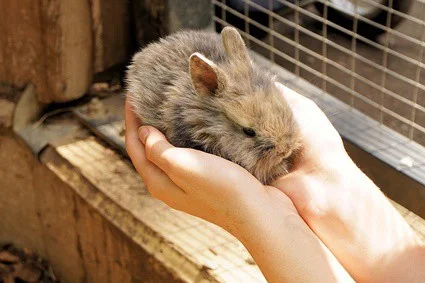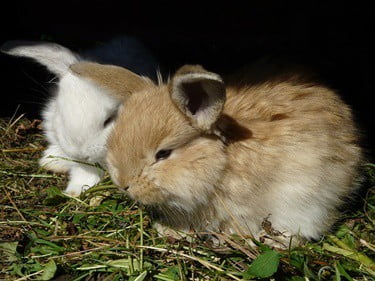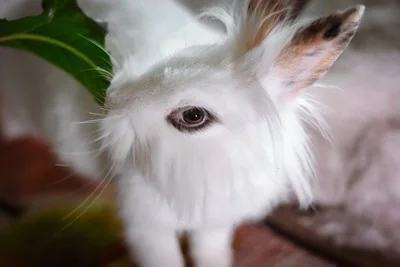Not only is it safe and easy to remove ear wax in rabbits, but it is also necessary. Cleaning your rabbit’s ears is a simple process and should be made a part of normal grooming sessions. Care does need to be taken to not push ear wax deeper into the ear, however. This can cause an ear infection to develop, as can over-regular ear cleanings.
Removing wax from your rabbit’s ears in a safe way involves patience, cotton swabs, and a cloth. As for cleaning solutions, there are home remedies, but warm water is enough. Start by interacting with your rabbit, either by petting or brushing it to initiate a grooming session. Once it is calm, inspect its ears. Larger pieces of dirt and ear wax can be removed with a pair of tweezers. As for the rest, dampen the cloth or swab and, using a ‘from the bottom to the top’ stroke, brush the gunk away. Keep going until all of the ear wax is gone.
A buildup of ear wax can cause an ear infection. These can affect the outer, middle, and inner ear. Each can cause discomfort and pain. Untreated, these infections can require surgery to cure, and can even result in permanent hearing loss and balance issues. Knowing the signs and symptoms of an ear infection will allow you to get your rabbit to the vet for treatment before the infection progresses too far.
Can Rabbits Get Ear Wax?
Rabbits have sensitive ears, and like many animals, rabbits will produce ear wax to keep their ears healthy. Self-grooming isn’t enough to prevent ear wax build-ups from growing out of control. Due to the complex structure of a rabbit’s ear, owners must regularly clean their rabbit’s ears for them. Not doing so can result in inflammation and infection of the ear.
Ear wax itself is produced by glands in the skin, and its purpose is to protect the inner ear against foreign materials. The sticky gunk and delicate inner ear hairs catch dust and dirt particles before they can reach the eardrum, keeping the inner ear clean and debris-free.
Ear wax isn’t wax at all either. It is a mixture of sebum, skin cells, sweat, and dirt. Should too much ear wax build-up, a number of uncomfortable and painful conditions can develop. Namely, ear infections. Rabbits are susceptible to a number of ear diseases, and also ear mites – which themselves can cause ear infections.
My Rabbit Has Ear Wax
All rabbits have ear wax. Lop-eared rabbits, though, are more susceptible to ear wax build-ups. The weak point of the ear canal that gives lop ear breeds their signature floppy ears is prone to wax build-ups and outer ear infections. There are five breeds of lop ear rabbits in the U.S.:
- French lop
- Holland lop
- English lop
- American fuzzy lop
- Mini lop
The Journal of the American Veterinary Medical Association found that lop-eared rabbits run a higher risk of developing middle ear infections too. The reasons for this are that ear wax builds up in the ear fold.
Without proper cleaning, which older rabbits may struggle with, this build-up can cause the ear canal to expand. Eventually, creating a cavity full of ear wax. This can be uncomfortable and cause ear infections to grow.

Can You Clean a Rabbit’s Ears?
You can indeed clean a rabbit’s ears. In fact, you should include ear cleaning as a regular part of your rabbit’s grooming schedule. Check your rabbit’s ears at least once a month. Obviously, if you see concerning signs, like head tilting or excessive scratching, you should check its ears.
Most rabbits will be able to clean their own ears without trouble. This does not mean that you shouldn’t clean its ears on occasion. Not only do you have actual hands, but you can use precise tools and solutions to clean its ears far more thoroughly.
Older rabbits and lop ear rabbits will struggle to thoroughly clean their own ears, and will require you to step in and help.
What To Use To Clean a Rabbit’s Ears
Regular, normal cleaning of a rabbit’s ears doesn’t require any special solution. A soft cloth with warm water is enough for regular cleaning. You can also use a cotton swab.
Ears with excessive wax may need a cleaning solution to loosen the gunk up. Have a chat with your vet about commercial solutions. There are home remedies, like honey and water or olive oil, that some suggest for cleaning away mild wax build ups. It is always best to take any home remedy with a grain of salt, though, and speak with a professional first.
Excessive ear wax can be stubborn. A chemical or medicated cleaning solution may be required. Your vet clinic will likely have a variety of rabbit safe cleaning solutions available.
A useful tool to have is also a head lamp. This will make it much easier to see the inside of your rabbit’s ear while you examine it. Alternatively, if you have someone helping you, a penlight will work just as well.
How To Clean a Rabbit’s Ears
Cleaning a rabbit’s ears must be done gently. These ears are delicate and must be handled as such. It is also important that, during this cleaning process, no ear wax or debris is pushed deeper into the ear canal.
Before attempting to clean the ear, or even inspecting it, you need to prepare your rabbit for a cleaning. A stressed rabbit will bite, kick, scratch, and struggle. Not only will this make cleaning its ears difficult, the rabbit may hurt itself by wriggling out of your grip. Interact with your rabbit beforehand, perhaps even initiate a grooming session by brushing it. This will coax it into a sedated state, making ear cleaning safer. If your rabbit becomes distressed, let it go and try cleaning its ears another day.
Once your rabbit is calm you should first inspect the ears. Carefully manipulate each ear and look for any wax build ups or mites. Shine the light so that you can see further down the ear canal. Are there any blockages or layers of ear wax? What about trapped debris? Larger pieces can be removed with blunt tweezers or with a cotton swab. Don’t push anything deeper into the ear though. This can be painful and cause an infection.
The next step is to wash the remaining wax away. Dampen a cloth with warm water or the cleaning solution. Gently wipe the rabbit’s ear from the bottom up. Continue this motion as the ear wax loosens, and don’t wipe from the tip down – this will push wax towards the ear canal. Keep going until all of the debris and wax is cleaned away.
Ensure that your rabbit is comfortable throughout this process. Grooming is a bonding experience between rabbits. A sign of affection! Treat it as such and your rabbit may enjoy having its ears cleaned.
The Importance of Ear Wax Removal In Rabbits
Cleaning a rabbit’s ears is an important part of rabbit ownership. Not only is this considered a grooming behavior in rabbits, and thus a sign of affection, it prevents any nasty infections from forming. A buildup of ear wax can cause bacterial and yeast to grow out of control, which develop further into ear infections.
Ear infections are broadly classified into 2 categories: outer ear infections, and middle and inner ear infections.
Middle And Inner Ear Infections
Middle ear and inner ear infections, otitis media and otitis interna, are an inflammation of the middle ear and inner ear respectively.
Middle ear infections can be caused by a number of things, including ear wax build up. A rabbit’s middle ear is an air-filled cavity between the ear rum and the inner ear. Outer ear infections that spread down to the eardrum can spread into a middle ear infection. Middle ear infections that generate pus can fill the cavity, putting pressure on the ear drum. The pus can build up and place pressure on the eardrum, causing it to burst.
As stated in The Journal of Experimental Medicine, upper respiratory tract infections with certain bacteria can easily infect the middle ear, causing an ear infection unrelated to ear wax.
The inner ear is a delicate and complex series of structures, some of which aren’t solely used for hearing. Infections of the inner ear are often accompanied by head tilting, as parts of the inner ear are used for balance – one of which is the labyrinth. Severe inner ear infections that damage the labyrinth can result in permanent balance issues and head tilt.
Asides from visual signs, a vet may use an x-ray to determine the severity of the infection. Pus build-ups will show up on an x-ray.
Outer Ear Infections
Outer ear infections, also called otitis externa, are an inflammation of the external ear canal.
In severe outer ear infection cases, surgery may be required. The Journal of the American Veterinary Medical Association notes that surgery can successfully treat severe cases of middle and outer ear infections. This procedure is complicated. Almost as complicated as the name for the surgery itself: total ear canal ablation and lateral bulla osteotomy.
Outer ear infections can also be triggered by upper respiratory infections and ear mites. In some cases, a rabbit’s hypersensitive skin may also be irritated, opening the skin to an infection which can extend into a case of otitis externa. This irritation could be from certain cleaning solutions marketed as ‘rabbit safe’ or from too-vigorous cleaning.
Untreated, outer ear infections can spread to the middle and inner ear, causing discomfort, pain, and impacting the overall quality of life. As said above, ear infections can cause permanent hearing loss if left unattended.
Identifying Ear Infections in Rabbits
As said in Vet Record, ear infections are commonly found in rabbits. They are the most prominent forms of ear disease that vets see. Partially, this is because a rabbit will often hide its pain or discomfort. Meaning that by the time the owner notices that something is wrong, the infection has progressed.
Asides from closely inspecting your rabbit’s ears on a regular basis, there are a number of signs to keep watch for. These indicate that there is something wrong with the rabbit, with an ear infection being a likely culprit.
Loss of Appetite
Usually, when a rabbit loses its appetite, you know something is wrong. It is always worth noting down when a rabbit refuses food. Ear infections can cause a rabbit to avoid eating for a few reasons.
Inner ear infections often play with an animal’s equilibrium. This can cause the rabbit to feel dizzy, which discourages it from eating. Furthermore, ear infections can make any movement of the jaw painful. Namely, the act of chewing.
A dizzy rabbit that can’t chew properly is hardly going to want to eat.
Head Tilt
The inner ear is where the balance organs are. Alongside dizziness, a rabbit may tilt its head constantly. This is called torticollis, or head tilt.
Laboratory Animals notes that heat tilt was a symptom of an ear infection in all but 1 of the rabbits studied.
A rabbit may tilt its head due to the infection playing havoc on the balance organs, or to alleviate pain.
A rabbit may also shake its head, as if it were trying to shake something loose, or rub its ear against a surface. Or, it may pin the ear down in pain. These actions may be accompanied by head tilt.
Discharge
A foul-smelling discharge may gather, or even leak, from the ear if there is an infection. Usually, a noticeable odor means that the infection is in the inner or middle ear.
The discharge of an infection looks somewhat like pus. It is white and thick, often creamy looking in appearance. An ear infection that has reached this point will likely also see redness and swelling of the ear.
Abnormalities
There are several other signs of ear infections developing. This includes crusts around the ear canal, fur thinning or patches of fur missing around the ear, and scaling around the ear canal.
Behavior
A rabbit that feels or unwell or is in pain is going to change its behavior. It may hide more than usual, shy away from affection and grooming, and warn off other rabbits or yourself with nips. Look for other signs of pain and discomfort, such as:
- Ears pinned back
- Hunched position
- Shivering
- Teeth grinding
- Bulging eyes
- Rapid or shallow breathing
A rabbit will also groom itself several times a day. Due to the pain, it may stop grooming.

Treating Ear Infections in Rabbits
Treatment for an ear infection will depend on the severity of the infection itself. Mild cases can usually be resolved by daily ear cleanings to remove ear wax.
Antibiotics and rabbits have a complicated relationship. Any vet that is knowledgeable about rabbits knows that they can only be prescribed a very limited selection of antibiotic treatments. A true ear infection will require a course of antibiotics, and possibly anti-inflammatories. Outer ear infections can be treated with antibiotic ear flushes, and persistent or middle and inner ear infections will see long-term antibiotic treatments applied.
Severe ear infections may require surgery to resolve. This surgery might be the procedure discussed above, or it may be a surgical ear flushing while the rabbit is under general anesthesia. Ear infections caused by ear mites will also involve an anti-parasitic treatment course.
Hard Ear Wax in Rabbits
Sometimes, ear wax build ups can harden into a solid mass of wax. This wax can form a plug, which can affect hearing and cause pain. Hardened lumps of ear wax will require either a vet to remove the plug or prescription treatment to soften and flush the plug free.
Rabbits with their ears plugged with wax may be hard of hearing. Perform a series of hearing tests and inspect your rabbit’s ears if you suspect that it is losing its ability to hear.
What Causes Ear Wax Build Up?
Ear wax naturally builds up over time. The body gradually flushes ear wax from the inner ear to the outer ear, where the rabbit can clean it away. Wax may build up for a number of reasons.
An older rabbit that develops arthritis may struggle to clean its own ears. As the joints stiffen, sometimes painfully, the rabbit will avoid straining itself for the sake of a bath. The same can be seen in disabled rabbits that struggle to move.
Lop ear rabbits have a more difficult time grooming ears. The characteristic ear flop of the lop eared rabbit makes the inside of the ear difficult to reach. Plus, the lack of control a lop ear rabbit has over its ear makes it almost impossible for the rabbit to do any cleaning of its ears without assistance.
In both of these cases, a lack of mobility and motility prevent a rabbit from cleaning itself properly. This allows ear wax to build up.
The last reason why ear wax builds up is in response to an infection or mite infestation.
Ear Mites
Ear mites are a small parasite that live, as you may have guessed, in the ears of animals. This parasite is called Psoroptes cuniculi. It can easily spread between animals, as it is able to live outside of the ear for days at a time in humid environments.
Ear mite infestations are often the cause of ear infections, especially in the outer ear. Don’t mistake canker for an ear wax build up either! Canker is a formation of thick, brown crusts inside the outer ear.
During ear cleaning sessions, if you notice this canker intermingled with ear wax, stop the cleaning session and sanitize any tools you used in boiling water. Take your rabbit to the vet as soon as you can for diagnosis and treatment. Ear mites aren’t lethal, but they can cause inflammation, discomfort, and pain. Untreated, ear mite infestations will cause a secondary infection.
Ear cleaning sessions for rabbits are an important part of rabbit ownership. A rabbit will clean its own ears during one of the many daily groomings it will perform.
It is still important for you to conduct regular ear cleanings to remove ear wax and debris from the ear. Ideally, these will happen monthly. This will also allow you to inspect its ears for any abnormalities, like redness, swelling, or discharge.
As a rabbit gets older, it may be unable to clean its ears properly. Lop ear rabbits, such as the Holland lop ear, will also struggle to clean their own ears. These rabbits will need more regular cleaning sessions. Not doing so can have consequences.
Ear wax build ups can cause bacterial and yeast infections to begin. Without treatment, these infections can become painful and cause permanent hearing loss and balance issues.


Could you show a demo of cleaning a Rabbits ears. I have a mini lop and no vet ever told me that I should be regularly cleaning his ears. Today I was given kitten drops and told to clean with cotton wool but I’m not sure exactly how to do this correctly as I was not given.a demo. How gentle or form should I be. How deep into the ear should I put the cotton wool to clean it. Can you show a dem to help educated?